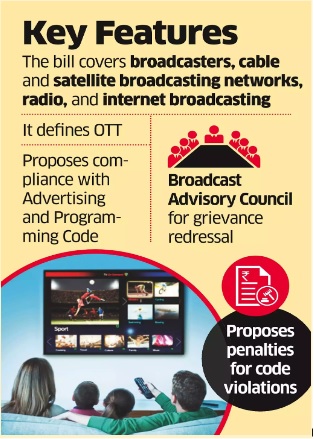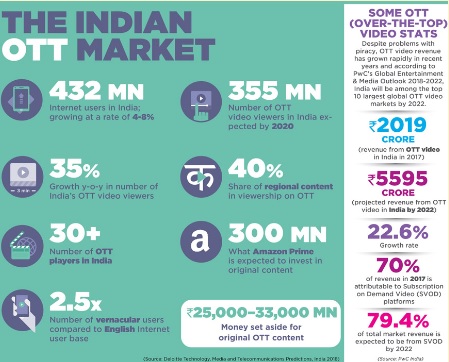Governance
Regulating OTT: Draft Broadcasting Regulation Bill, 2023
- 16 Nov 2023
- 12 min read
This editorial is based on “Regulating OTT: Draft Broadcasting Regulation Bill may be an attempt to control digital infrastructure” which was published in the Indian Express on 16 /11/2023. It talks about the introduction of the Broadcasting Services (Regulation) Bill, 2023, and raises concerns about whether the focus is genuinely on public service or on increasing control and regulation.
For Prelims: Broadcasting Services (Regulation) Bill, 2023, Cable Television Networks Regulation Act of 1995, OTT platforms, Digital media regulation.
For Mains: Key Features of the Draft Broadcasting Regulation Bill, 2023, Arguments in Favour of the Bill, Arguments Against the Bill, Steps Ahead for Effective Broadcasting Regulation in India.
The Cable Television Networks (Regulation) Act of 1995, governing linear broadcasting for three decades, faces challenges due to technological advancements and the emergence of new platforms like DTH, IPTV, and OTT.
Thus, the Ministry of Information and Broadcasting in India has proposed the Broadcasting Services (Regulation) Bill, 2023, recognizing the need for a comprehensive law to streamline the regulatory framework in the digitized broadcasting sector.
The bill, seemingly a forward-looking and adaptable framework for the evolving media industry, sets the tone for the future of broadcasting regulation in India.
What are the Key Features of the Draft Broadcasting Regulation Bill, 2023?
- Consolidation and Modernisation:
- It addresses a long-standing need to consolidate and update the regulatory provisions for various broadcasting services under a single legislative framework.
- It extends its regulatory purview to encompass broadcasting over-the-top (OTT) content and digital news and current affairs currently regulated through the IT Act, 2000 and regulations made there under.
- Contemporary Definitions and Future-Ready Provisions:
- To keep pace with the evolving technologies and services, the bill introduces comprehensive definitions for contemporary broadcasting terms and incorporates provisions for emerging broadcasting technologies.
- Strengthens the Self-Regulation Regime:
- It enhances self-regulation with the introduction of ‘Content Evaluation Committees’ and evolves the existing Inter-Departmental Committee into a more participative and broader ‘Broadcast Advisory Council’.
- Differentiated Programme Code and Advertisement Code:
- It allows for a differentiated approach to Programme and Advertisement Codes across various services and requires self-classification by broadcasters and robust access control measures for restricted content.
- Accessibility for Persons with Disabilities:
- The bill addresses the specific needs of persons with disabilities by providing for enabling provisions for the issue of comprehensive accessibility guidelines.
- Statutory Penalties and Fines:
- The draft Bill introduces statutory penalties such as advisory, warning, censure, or monetary penalties, for operators and broadcasters.
- Provision for imprisonment and/or fines remains, but only for very serious offenses, ensuring a balanced approach to regulation.
- Equitable Penalties:
- Monetary penalties and fines are linked to the financial capacity of the entity, taking into account their investment and turnover to ensure fairness and equity.
- Infrastructure Sharing, Platform Services, and Right of Way:
- The bill also includes provisions for infrastructure sharing among broadcasting network operators and carriage of platform services.
- Further, it streamlines the Right of Way section to address relocation and alterations more efficiently and establishes a structured dispute resolution mechanism
What are the Arguments in Favour of the Bill?
- Updated Legal Framework:
- The bill marks a transition from the Cable Television Networks Regulation Act of 1995.
- It is described as a "pivotal legislation" by the Information & Broadcasting Minister as it aims to modernize the regulatory framework, adapting to the dynamic world of OTT, digital media, DTH, IPTV, and emerging technologies.
- It also provides comprehensive accessibility guidelines for the Divyangjan community.
- The bill marks a transition from the Cable Television Networks Regulation Act of 1995.
- Empowering Broadcasters:
- It Introduces provisions to empower broadcasters with self-regulation mechanisms.
- It aims to strike a balance between regulatory oversight and industry autonomy.
- Differentiated Approach to Codes:
- The draft Bill also “allows for a differentiated approach” to Programme and Advertisement Codes across various services.
- By allowing a differentiated approach, regulations can be tailored to suit the nature of linear and on-demand content, providing more flexibility and relevance to content creators.
- Fairness Measures:
- Under this bill, monetary penalties are linked to the investment and turnover of the entity for fairness. Penalties are proportionally determined based on the entity's financial standing.
- Larger corporations with higher investments and turnovers may face higher fines compared to smaller entities with limited financial capacity.
- Stakeholder Involvement:
- The bill indicates the involvement of stakeholders through public consultation. The industry is welcoming the government's initiative for a unified law, anticipating it to streamline compliance and enforcement processes.
What are the Arguments Against the Bill?
- Apprehensions of Control and Regulation:
- The bill raises concerns about whether the focus is genuinely on public service or on increasing control and regulation by the government.
- There are apprehensions that the Bill may intensify government control over digital infrastructure and citizens' viewing choices
- Ambiguous Provisions in the Draft:
- A specific provision (point 36) in the draft, emphasizes the broad and ambiguous language that grants authorities the power to prohibit content.
- Raises questions about the influence of "authorized officers" working under government direction.
- Potential Impact on Minority Communities:
- The bill raises concerns that the bill might lead to the erasure or selective representation of Indian minority communities.
- The vague language in the draft could be exploited to promote a universal majority identity of India.
- Issues with Cable Regulation:
- Cable Television Networks (Regulation) Act,1995 initially aimed at curbing illegal cable operators, lacked transparency due to the nexus involving operators, politicians, entrepreneurs, and broadcasters.
- The new bill fails to address the loopholes and issues in the implementation of the existing Act including conflicts of interest and opaque practices within the Indian media industry.
- Government's Trust Deficit:
- The bill examines the recent history of the ruling government with media regulation, highlighting a pattern of unfulfilled promises and questionable outcomes.
- The bill draws parallels with the controversial IT Rules, 2021 introduced for national welfare.
- Oligopolistic Media Ownership Tendencies:
- Amid debates on "cultural invasion" and "anti-national" programming, the nexus of government officials and media houses may promote oligopolistic media ownership.
What are the Steps Ahead for Effective Broadcasting Regulation in India?
- Comprehensive Legislation:
- Develop a comprehensive and modern legislative framework that encompasses all aspects of broadcasting, including traditional television, OTT platforms, digital media, and emerging technologies.
- Encourage competition among broadcasters and content creators to foster diversity of content. Avoid concentration of media ownership to ensure a plurality of voices and perspectives.
- Stakeholder Consultation:
- Prioritize stakeholder consultation to gather insights from industry experts, content creators, broadcasters, and the public. Ensure a diverse range of perspectives to create well-informed regulations.
- Adaptability to Technology:
- Design regulations that are adaptable to technological advancements. Consider the rapidly evolving nature of the media landscape and ensure that regulations remain relevant and effective over time.
- Content Classification and Ratings:
- Implement a robust content classification and rating system to provide clear guidelines for audiences. This ensures that viewers can make informed choices, and it helps in regulating content based on appropriateness.
- Independent Regulatory Body:
- Establish an independent regulatory body with the authority to enforce and monitor compliance. Ensure transparency, impartiality, and accountability in regulatory decisions.
- Differentiated Approach for Platforms:
- Recognize the diversity of broadcasting platforms, including traditional TV, OTT, and digital media. Adopt a differentiated approach in regulation, acknowledging the unique characteristics and challenges of each platform.
- Regular Review and Update:
- Establish a mechanism for regular review and update of regulations. This allows the regulatory framework to stay abreast of technological changes, societal shifts, and emerging challenges.
- Clear Enforcement Mechanisms:
- Define clear enforcement mechanisms for regulatory violations. Establish a fair and efficient process for handling complaints, investigations, and sanctions to maintain the integrity of the regulatory framework.
- Promote Media Literacy:
- Invest in media literacy programs to educate the public about responsible media consumption. Informed viewership contributes to a healthier media environment and reduces the need for excessive regulatory measures.
- International Best Practices:
- Study and incorporate international best practices in broadcasting regulation. Learn from the experiences of other countries to adopt effective strategies while considering the unique cultural and social context of India.
Conclusion
The Broadcasting Regulation is not just about compliance but about creating an environment that encourages growth, innovation, and equitable access to communication services. By finding the optimal equilibrium between regulatory supervision and industry autonomy, India can strategically position itself for long-term success in the swiftly advancing telecommunications sector.
Legal Insights: Broadcasting Services (Regulation) Bill, 2023
https://www.drishtijudiciary.com/en
|
Drishti Mains Question: What are the primary concerns in crafting the Broadcasting Services (Regulation) Bill, 2023, in India? Suggest policy strategies aimed at instituting and sustaining robust regulations for the telecommunications sector in the country. |
UPSC Civil Services Examination, Previous Year Question (PYQ)
Prelims:
Q. In India, it is legally mandatory for which of the following to report on cyber security incidents? (2017)
- Service providers
- Data centres
- Body corporate
Select the correct answer using the code given below:
(a) 1 only
(b) 1 and 2 only
(c) 3 only
(d) 1, 2 and 3
Ans: D
Mains:
Q.Data security has assumed significant importance in the digitized world due to rising cyber crimes. The Justice B.N. Srikrishna Committee Report addresses issues related to data security. What, in your view, are the strengths and weaknesses of the Report relating to the protection of personal data in cyberspace? (2018)









